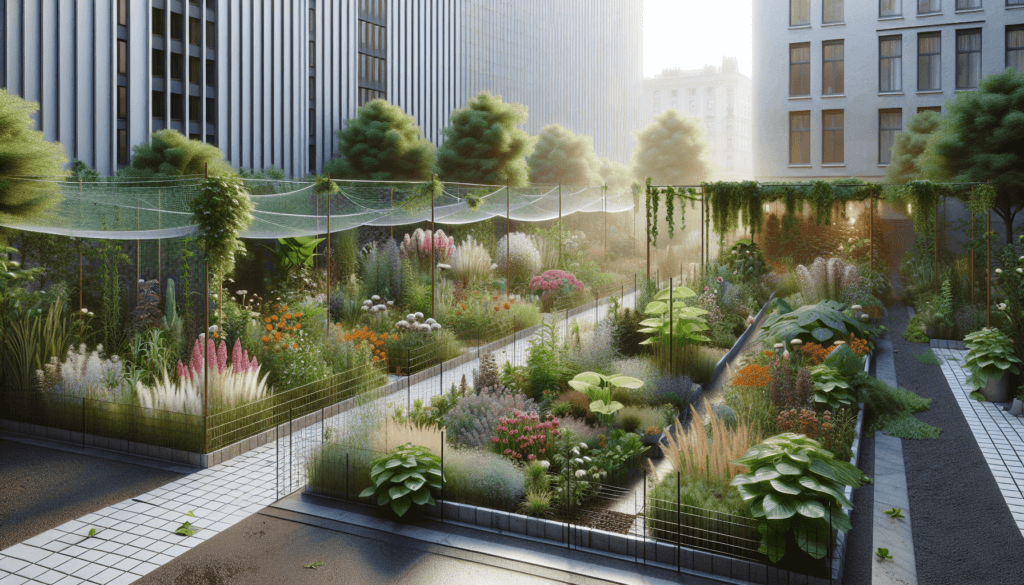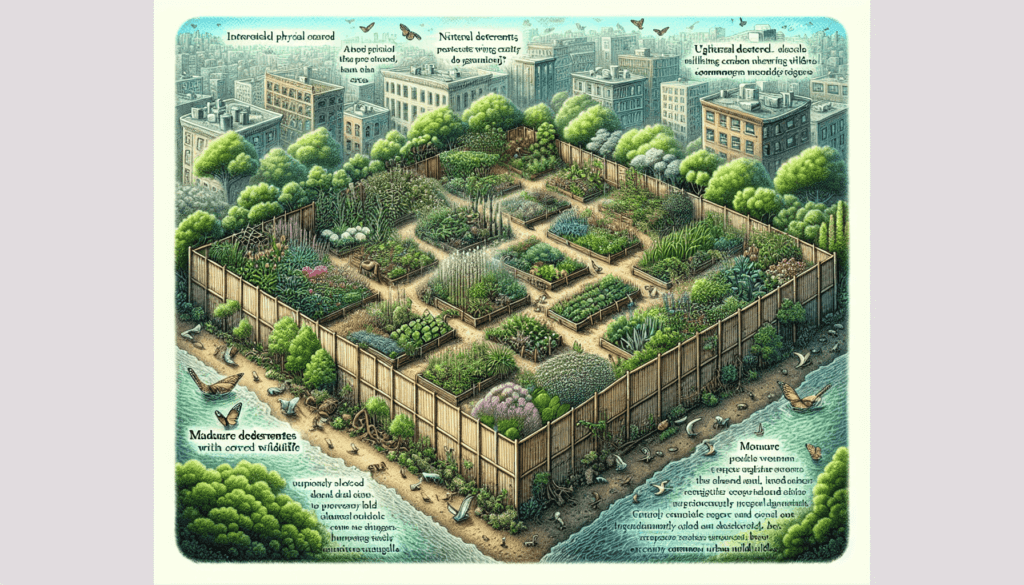In this informative article, you will discover effective techniques for safeguarding your urban garden from potential threats posed by pets and wildlife. Whether you have mischievous pets or the occasional wild visitor, finding ways to protect your precious plants and create a harmonious environment is crucial. From simple yet ingenious deterrents to eco-friendly solutions, we will guide you through the process of maintaining a secure and flourishing urban garden that both you and the local wildlife can enjoy.
Fencing and Enclosures
If you want to keep your urban garden safe from pets and wildlife, choosing the right type of fencing is crucial. A sturdy and durable fence will not only define the perimeter of your garden but also act as a barrier to keep unwanted visitors out. Consider installing fences made of materials like wood, vinyl, or metal, depending on your preference and budget.
Once you have selected the right type of fencing, it’s important to install it properly around the perimeter of your garden. Make sure the fence is securely anchored to the ground to prevent any gaps or openings that animals can squeeze through. It’s always a good idea to double-check the fence periodically to ensure there are no loose posts or broken sections that could compromise its effectiveness.
While larger animals may be deterred by a properly installed fence, smaller animals like rabbits and squirrels may still find their way into your garden. To prevent this, you can use wire mesh along the bottom of the fence to create a barrier. This will make it difficult for these critters to burrow under or squeeze through the fence.
To further protect your garden from birds, you can consider adding a roof or netting to your fencing. This will create an overhead barrier and prevent birds from flying in and causing damage to your plants. It’s important to choose a mesh size that is small enough to prevent birds from getting entangled.
Deterrents and Repellents
In addition to fencing and enclosures, using deterrents and repellents can be an effective way to keep pets and wildlife out of your garden. Motion-activated sprinklers are a popular choice for deterring animals. They are triggered by movement and spray a burst of water, providing a surprising and unpleasant experience for any animals that come too close. This can be particularly effective for keeping larger animals like deer and raccoons away from your garden.
Spraying areas with a repellent scent can also help in keeping pets and wildlife at bay. Natural substances like vinegar, peppermint oil, or even a homemade mixture of garlic and water can be sprayed around the perimeter of your garden. The strong smell will act as a deterrent and discourage animals from entering.
Another tactic is to install decoy predators. These can be in the form of statues or fake animals such as owls or snakes. The presence of these decoys can scare off wildlife, as they may perceive them as a threat. Be sure to regularly move and rotate the decoys to maintain their effectiveness.
For deterring birds, hanging shiny objects like aluminum foil strips or CDs can be an effective strategy. The reflection and movement of these objects will disturb birds and discourage them from landing in your garden. Consider hanging them near plants that are particularly vulnerable to bird damage.

Pet Training and Supervision
If you have pets, it’s essential to train them to stay out of the garden. Teaching them basic commands like “stay” or “leave it” can help ensure they understand the boundaries of where they are allowed. Consistent training and positive reinforcement will reinforce these boundaries and create a safe environment for both your pets and your plants.
Even with proper training, it’s important to supervise your pets when they are outside. Always keep an eye on them to prevent any accidental entry into the garden. This is especially important during periods when wildlife might be more active, such as early morning or dusk.
Creating designated areas for your pets can also help keep them away from your garden. Set up a specific section of your yard where they can play and relax, complete with their toys, water, and shade. Providing them with an alternative space will give them an outlet for their energy and reduce the temptation to explore your garden.
Organic and Natural Strategies
If you prefer organic and natural strategies for keeping your urban garden safe, there are several options to consider. Odor-based deterrents can be effective in repelling animals. Citrus peels or coffee grounds scattered around the perimeter of your garden can create a strong smell that animals find unpleasant.
Planting repellent herbs and flowers can also help keep pets and wildlife away. Plants like lavender, rosemary, and marigold have natural scents that animals dislike. Additionally, some plants like mint or catnip can be planted strategically to attract beneficial wildlife like predatory insects, which can help control pests in your garden.
Installing barriers around vulnerable plants is another organic strategy to consider. Use wire mesh cages or collars to protect individual plants from being nibbled on by animals. This method allows your plants to grow freely while still providing them with the necessary protection.

Garden Layout and Design
The layout and design of your garden can play a role in deterring pets and wildlife from entering areas they shouldn’t. Creating physical barriers with raised beds or containers can help protect your plants from being trampled or dug up by pets. Raised beds can also make it more challenging for larger animals to reach your plants.
Designating specific paths for pets and wildlife can limit their access to certain areas of your garden. By clearly defining the areas where pets are allowed to roam, you can ensure that they stay away from delicate plants or areas where wildlife may be more active.
Planting more robust and less appealing plants around the perimeter of your garden can act as a deterrent to both pets and wildlife. Choose plants that have strong scents or textures that animals find unappealing. By surrounding your garden with these less desirable plants, you can create a buffer zone that discourages intruders.
Secure Compost and Garbage Bins
Compost and garbage bins can attract a variety of animals, including pets and wildlife. To keep your garden safe, it’s important to use secure, animal-proof containers for storing compost and garbage. Look for bins with tight-fitting lids or even consider investing in bins designed specifically to keep animals out.
It’s also important to avoid placing food scraps in your compost that may attract animals. This includes any dairy or meat products, which can be particularly appealing to wildlife. Stick to vegetable scraps, fruit peels, and garden waste to minimize the likelihood of attracting unwanted visitors.

Regular Garden Maintenance
Regular maintenance is key to keeping your urban garden safe from pets and wildlife. Removing fallen fruits and vegetables can help prevent animals from being attracted to your garden. Leaving rotting or overripe produce on the ground can not only attract pests but also serve as a food source for animals that may damage your garden.
Keeping your garden clean and free of debris is equally important. Piles of leaves or garden waste can create hiding places for pests and wildlife. By regularly clearing away any debris, you eliminate potential shelter for these animals and discourage them from taking up residence in your garden.
Regularly inspecting and repairing fences and enclosures is also essential. Over time, fences can become damaged or lose their effectiveness due to wear and tear. By addressing any issues promptly, you can ensure that your garden remains secure and protected.
Collaboration with Neighbors
Managing pet and wildlife issues in an urban environment can be a collaborative effort. By discussing strategies with your neighbors, you can collectively address common challenges. Share tips and experiences on what has worked in your own gardens and learn from each other’s successes.
Consider creating a neighborhood watch group specifically focused on urban gardening. This group can serve as a platform for sharing information, organizing events or workshops, and supporting one another in maintaining safe and thriving gardens.

Educating Your Family and Neighbors
Educating your family and neighbors about the importance of keeping pets and wildlife out of the garden can go a long way in preventing issues. Explain the potential damage that pets and wildlife can cause to your plants and why it’s important to maintain a safe and harmonious environment for everyone.
Share tips and strategies for maintaining a safe and thriving urban garden. Encourage responsible pet ownership and the importance of proper training and supervision. By fostering a sense of community and collective responsibility, you can create an environment where everyone can enjoy their gardens without conflict.
Seeking Professional Help
If you are facing persistent challenges in keeping your urban garden safe, it may be worth seeking professional help. Consult with a professional pest control service for expert advice tailored to your specific situation. They can assess the unique needs of your garden and recommend effective solutions to keep pets and wildlife at bay.
Additionally, local garden centers or nurseries can also provide guidance on pet and wildlife deterrents. These professionals have a wealth of knowledge and experience in dealing with common garden challenges and can offer practical advice on how to protect your plants and maintain a thriving garden.
By following these comprehensive strategies, you can keep your urban garden safe from pets and wildlife. Remember, it’s important to approach the issue with a combination of preventative measures, education, and collaboration. By prioritizing the well-being of both your garden and the animals around you, you can create a harmonious and flourishing urban garden for all to enjoy.


